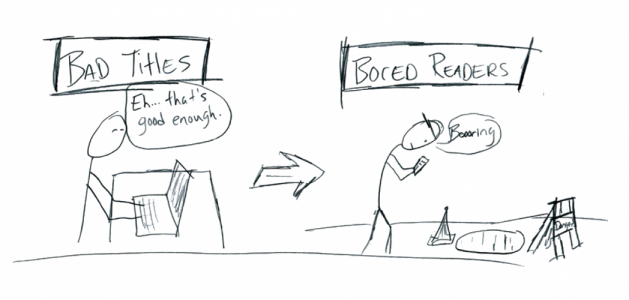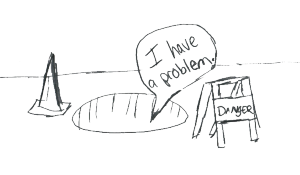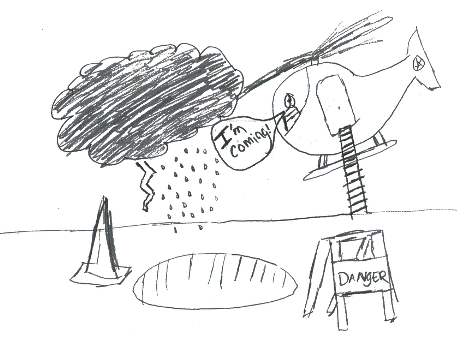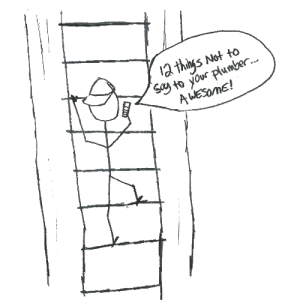Writing compelling post titles can be challenging and time consuming. But if you don’t put the necessary time and energy into it, you could be blowing your biggest chance to pull additional readers to your article.

There are a lot of copywriting strategies out there that can be more or less effective in reducing the time and stress involved with writing. In this guide I will lay out the one fool-proof strategy that I reccomend that can help you quickly craft the perfect titles.
Note: This strategy applies mostly to articles that are about a topic or an idea; applying it to newsy type articles may be a challenge. You can probably find one that will work for you here.
The strategy has three simple steps.
Step 1: Identify the problem
What is the problem, pain point, or circumstance that you are discussing in your article? Identify what it is and then state is as simply and clearly as you can. (If you are struggling to identify what the exact problem is, perhaps the article is too broad or vague.) Don’t try to be overly complicated or clever. The idea is to simply have your reader say ‘Yep, that’s a problem.’
Another quick way to discover the problem presented in your article is to ask: ‘Who specifically should read this article?’. If you can answer in the form “Anyone who struggles to ____________” then you have identified the problem.
For example, here are a few problems that I might write about in the future:
- Your click-through rate is very low.
- People come to your site but leave right away.
- You know that you should be writing more articles, but you can’t find the motivation.
Step 2: Aggravate the problem
Once you have identified the problem, the next step is to aggravate it.

If your reader identified with the problem, now you need to make them see the effects that the problem is causing. You can do this in one of two ways:
- By describing the terrible world where the problem isn’t solved
- Or by describing the wonderful world where the problem is solved
Both of these ways are effective ways to show the effects of the problem. The key to this section is balance the 4 Cs: Colorful, Creative, Concise, and Clear. You must be clear but also let your creativity shine!
Here are my examples above using the terrible world method:
- Your click-through rate is very low. Why even bother writing articles if no one ever reads them?
- People come to your site but leave right away. Your sponsors aren’t going to stick around much longer.
- You know that you should be writing more articles but you can’t find the motivation. If you’d rather mow the lawn then write, something must be wrong.
And the same examples using the wonderful world method:
- Your click-through rate is very low. Imagine if every title you wrote was clicked.
- People come to your site but leave right away. They should be losing their jobs for spending so much time on your site.
- You know that you should be writing more articles but you can’t find the motivation. What if you had so much to write about, you forgot to take your lunch break.
If you aggravate the problem in the right way, you’ll leave the readers anxious to solve the problem…
Step 3: Solve the problem
You’ve identified the problem. You’ve aggravated it by painting a terrible picture or a wonderful picture. The final step is to offer the solution.

Since we are just writing titles, we usually can’t write out the entire solution. Instead, we just need to tease the solution. Show the reader that we have the solution and that they should come get it. Sometimes a promise is enough. Sometimes you can give away a little bit of the solution and draw them in for the rest.
Let’s finish up my examples.
- Your click-through rate is very low. Imagine if every title you wrote was clicked. The answer is three simple letters: PAS.
- People come to your site but leave right away. They should be losing their jobs for spending so much time on your site. Here are 3 ways to reduce your bounce rate.
- You know that you should be writing more articles but you can’t find the motivation. What if you had so much to write about, you forgot to take your lunch break. See the plan that is used by authors all over the world to increase their productivity.
As you can see, we identify a problem, avagrate it, and then offer a solution. We now have titles that are compelling and drive more traffic.
And by the way… this strategy also works well for writing the content of the articles as well!
 If you properly use this strategy, not only will you increase your audience’s response but the time required should be greatly reduced also. And what should you do with this extra free time? One option is to use Title Experiments to experiment on your audience by writing multiple titles per article. By actively and intentionally experimenting, you can hone your title writing skills and become a master.
If you properly use this strategy, not only will you increase your audience’s response but the time required should be greatly reduced also. And what should you do with this extra free time? One option is to use Title Experiments to experiment on your audience by writing multiple titles per article. By actively and intentionally experimenting, you can hone your title writing skills and become a master.